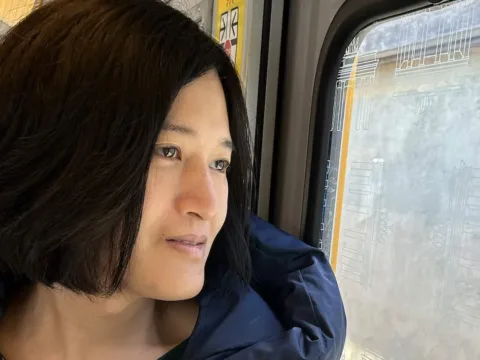In her second album, This is My Letter to the World, Kate Amrine explores an array of current social and political issues through the lens of contemporary classical trumpet performance. The album features music by Gemma Peacocke, JacobTV, Niloufar Nourbakhsh, Ruby Fulton, Kevin Joest, inti figgis-vizueta, Jay Rizzetto, Howie Kenty, and the performer herself. The track list reads like a shorthand manifesto, with titles such as My Body My Choice, Thoughts and Prayers, Skin, and We Are Women. Although some of the works teeter between poignant and heavy-handed, more often than not, they successfully encourage reflection, dialogue, and action.
Ruby Fulton wrote I’m Sorry Not Sorry after learning that Hillary Clinton was the first presidential candidate in U.S. history to use the words, “I’m sorry” to her supporters in her concession speech after losing the 2016 election. Throughout the work, the phrases “I’m sorry” and “I’m not sorry” are spoken with hypnotic steadiness, using harmonies from Beethoven’s Piano Sonata, Op. 110. Amrine accents certain moments in the cadence of the text with single pitches on the trumpet, while Kate Barmotina provides a counterpoint with viola and vocals. I’m Sorry Not Sorry does an excellent job of communicating a wealth of emotional nuance with a simple yet effective text.

Niloufar Nourbakhsh takes a similarly pithy approach to text in My Body My Choice. The work opens with an expansive, vibrato-heavy trumpet solo; a low, modulating electronics track joins in and the trumpet playing becomes more pointillistic and questioning. A woman’s voice repeats the mantra “my body my choice,” first as a whisper, but before long, it grows to declamatory shouting that is mirrored in Amrine’s trumpeting. Sitting at just two and a half minutes, this is one of the shortest and yet most impactful tracks. Like Fulton, Nourbakhsh uses minimal text to great effect, and the formal simplicity leaves room for Amrine’s timbral wizardry to shine.
Amrine’s What We are Doing to Ourselves is a call to action on environmental protection and features text from the farewell letter of LGBT rights lawyer David S. Buckel, a martyr who self-immolated in Brooklyn’s Prospect Park in early 2018. The chamber work cobbles together elegant, nostalgic music on winds and strings, the sounds of a forest fire, and Amrine’s chant-like setting of Buckel’s letter; the movement abruptly ends with her distorted voice and a chilling quote, “My early death by fossil fuels reflects what we are doing to ourselves.”
Although many works on this album use text, there are a few that do not. Linger by inti figgis-vizueta is a rumination performed on trumpet and bass clarinet (Ford Fourqurean). The instruments often imitate one another, at times circling in wide orbits and others descending into tighter spirals of repeated material. The moments where the duo synchronize are striking. In the journey of the album, the break from text-heavy pieces afforded by this track is a welcome change. In the context of the pieces that came before, the tensions and gestures in Linger become rich sites for reflection.

The other textless work on this album is Gemma Peacocke’s Skin. As an immigrant to the United States from New Zealand, Peacocke drew inspiration from her struggle to understand the (white) American idea of race and fixation on skin. At times, the electronics stretch out taut drones; at others, they soften and create a more fluid space, perhaps capturing something of the shape shifting nature of identity, community, and self. Motives on the trumpet emerge from and descend into the electronics; Peacocke does an excellent job of creating a sound world brimming with urgency.
If this sampling is any indication, This is My Letter to the World is chock-full of pieces that overtly tackle some timely social and political issues. With a variety of approaches to contemporary trumpet performance, these works are a testament to the resilience of the trumpet as a solo instrument, and to Amrine’s creativity in curating and advocating for this repertoire. Taken as a whole, the album is overwhelming in its scope; yet it also succeeds in creating a musical manifesto, one that is thought-provoking and alarming in the best way possible.
























